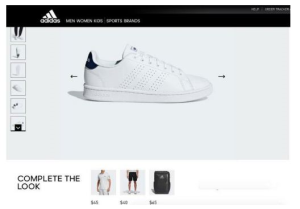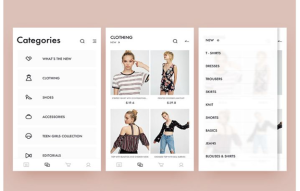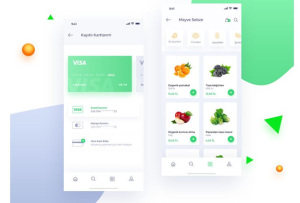eCommerce app is going to be the next revolution
This is not a tagline but a reality coming into the picture very soon.
Why we are saying this?
Just read the brief journey of how eCommerce app evolved since Amazon and eBay created a sensation by developing the world’s first successful eCommerce websites, and you will understand the fact.
The evolution of eCommerce started in 1969 when Dr. John R. Goltz and Jeffrey Wilkins established the first significant eCommerce company by utilizing a dial-up connection. But it took a big jump in 1995 when Amazon and eBay launched their first eCommerce websites which got successful in the market.
And the rest of story you know what today Amazon is.
But there is a twist in this journey,
eCommerce websites started thriving amazingly since its evolution and still continues to grow but with the emergence of smartphones in 2010, consumers started relying on eCommerce apps for online shopping.
And today, eCommerce apps are taking over eCommerce websites.
So why ultimately we told you about the journey of eCommerce?
Smartphones have heavily influenced consumer online shopping behavior. They feel lazy to sit in front of their Desktop PC or open laptop. Now, consumers depend on eCommerce applications to purchase products online through their smartphones. Here are the recent data regarding the eCommerce app growth:
- 79% of smartphone users order products online from their mobile devices
- 35% of US consumers use only eCommerce apps to shop online
- Conversion rates from mobile eCommerce apps are 3x greater than that of mobile websites
- 53% of smartphone users make purchases from the company’s dedicated mobile apps
These figures simply suggest that there is no sense to ignore mobile traffic. Having an eCommerce app for your online store will bring you the following advantages:
- Improved customer loyalty
- Increased conversions
- High-loading speed
- Meeting customer’s expectation
- Enhanced user experience
This trend has compelled other businesses and industries to develop a mobile app to increase their sales and business revenues. Therefore, retailers, eCommerce companies, and other business who want to boost their sales they must adopt an eCommerce app.
Today, eSearch Logix will tell you smart strategies for your eCommerce app that can speed up your sales and business revenues.
This blog is for those businesses which already have an eCommerce app but struggling to improve their sales growth and for those retailers, small business owners who have not yet realized how using an eCommerce app can reach more customers and uplift their business scale.
“You can’t just open a website and expect people to flood in. If you really want to succeed you have to create traffic.”-Joel Anderson, Walmart CEO
So, let’s get started.
Table of Contents
Toggle- 1. Make Your App Easy Searchable To Drive Organic Traffic
- 2. Use Referral Marketing
- 3. Build an in-app community
- 4. Use the power of Social Media Marketing
- 5. Introduce users to your app with onboarding
- 6. Personalize the User Experience
- 7. Track In-app events and A/B Test
- 8. Use Deep Linking
- 9. Create a beautiful app design
1. Make Your App Easy Searchable To Drive Organic Traffic
There are various methods to do it:
Optimize the app for the app stores (ASO)
ASO is the search engine optimization for mobile applications. It helps users search your app in the Google Play Store and Apple App Store by keywords and categories. If users are not downloading your eCommerce app, then by using ASO you can enhance the number of app downloads with the following additional benefits:
High retention rate: As compared with contextual advertising, the return rate of customers who installed eCommerce apps by using organic search is better, and the percentage of uninstalls is lower.
User loyalty and LTC: Users who have installed the eCommerce app from organic search in the store are highly interested in using it regularly. Such an audience shows higher LTV than those users who came via paid channels.
Support and enhancement of ad campaigns: ASO is essential if you plan or run contextual advertising in Google Ads to download a mobile application. Google utilizes application metadata such as keywords and builds an audience database based on it. For generating traffic from other channels due to improved usability, the conversion grows and the CPI decreases.
If you want more insights, read our blog: Great ASO Tips to Rank Your App on Google Play Store
Create a landing page for the app
A landing page is among the most effective techniques for promoting an eCommerce mobile app. It is a one-page website or web page which describes the primary features and functionality of the software product.
Its main goal is to encourage users to download and install the app on their smartphones. To make this happen, you can utilize these three most common actions:
- Subscription: Collecting a database of users interested in the app
- Bonus Programs: Customers are attracted to promo codes and discounts
- Download links: Buttons with attractive lines and QR codes.
Landing pages of an app’s life cycle may differ only in a call to action, so it is not essential to create a page from scratch every time. For example, if you take a look at how clothing brand Gwynnie Bee offers a discount on its landing page:
On this landing page, you can simply drive traffic to download your eCommerce app with discount offers.

Leverage the power of email marketing
Email marketing is to send commercial messages via email to a targeted group of people by using special tools.
Despite the rising wave of new merging technologies, emails and newsletters are still considered one of the most powerful marketing instruments. Email campaigns include special offers and sales coupons which enhance the growth of business and speed up conversion and sales.
2. Use Referral Marketing
Referral marketing is a user acquisition model based on the recommendation of products to friends for a reward. Its method is simple. A member of the referral program (referrer) receives an affiliate link or a unique promotional code, encourages other people to follow the link.
Then after a successful conversion, the referrer receives a bonus. Referral marketing is an effective solution for eCommerce apps with the following benefits:
- Your app gets additional audience coverage and due to a number of recommendations, your app gets more users.
- The level of trust in your brand from the attracted leads is higher than those which come from ads or media
- You have the freedom to decide what and how to reward the referred (for sales, conversions, leads)
See how Freshly, a food delivery app, motivates its users to refer their friends.

3. Build an in-app community
Almost every eCommerce mobile application builds its community on social media platforms. However, a branded in-app community is a more powerful tool than social media, do you know this?
Companies that own a community inside their eCommerce app get 100% reach to their customers whereas, for social media platforms, the organic reach is only up to 5.2%.
As a result, eCommerce companies have to pay for ads to reach their own app users. That is why to save costs and get more organic traffic, we recommend you building an in-app community.

You can learn from ModeCruz, an online marketplace for pre-owned luxury fashion items. It has a personalized activity feed that users can filter as per their interests. Just like on social media, they can like and comment on each other’s posts that substantially improve the user experience and boost the retention rate.
4. Use the power of Social Media Marketing
If you determine to build your own in-app community instead of creating one with the support of social media platforms, it doesn’t mean that you have to take the importance of social media lightly. Social media is a kind of digital world where people remain active most of the time.
Therefore, you can use them to promote your eCommerce app and create a buzz around your brand. Many eCommerce companies hold contests on Facebook or Instagram, rewarding their customers for reposts on social media channels. In this way, you can tell even more people about your products and services.
And if you want to promote your app on various social media channels, video marketing is another way to make your eCommerce app popular. Read our blog that will guide you Step-by-Step on how to make your app popular with video marketing?
5. Introduce users to your app with onboarding
Many mobile applications use various “introductory” screens to guide users. They typically show them right after the first launch. Here are the main rules which will help you rightly onboard the users of your eCommerce app:
Be concise: Focus on the most important features of the app, and then ask them to sign up or enter the app.
Visualize the information: People now generally don’t like to read text so try to visualize what is written on each slide
Do not always go for sales: Users are always ready to purchase products provided that they are convinced they are buying from a good brand. Therefore, you should avoid too much-targeting users for purchasing products. Talk with the users as if they were your friends.
Allow users to skip the tutorial: Usually, people don’t have time to learn all of your cool stuff. Therefore, it is better to give them an option to skip the onboarding and, or resume it later.
Just see how the Zappos brand onboards its users by offering a “quick tips” overlay after a user signs in to explain every icon.

6. Personalize the User Experience
Users are humans, not robots who will follow your all commands. They have feelings to understand how much a brand cares for them. Therefore, the personalization of eCommerce applications is the most visible trend in recent years.
A one-to-one approach to the customer is becoming a new practice in the eCommerce industry. Personalization means offering certain functionality or features to users based on his or her behavior pattern.
An eCommerce mobile app with personalized features provides actions that users could perform with their own interest. This method helps the users to quickly purchase or solve other problems.

If you want your eCommerce app provides an engaging personalized user experience, you should learn from the Adidas app that recommends products to users by allowing them to visualize the shoes of the same style in different colors.
7. Track In-app events and A/B Test
Before you can optimize the user funnel, you need to first understand where users are failing to convert. By measuring engagements such as installs, purchases, and registrations, you can learn which channels deliver high-value users.
A/B testing is an effective marketing method that can help you improve the performance of your mobile application. eCommerce app development company in India highly relies on A/B testing because it helps increase the conversion of landing pages, choose the optimal ad titles in ad networks, and enhance search quality.
The idea behind A/B testing is simple. You randomly divide the app users into segments. One of the segments remains unchanged- it is the control segment “A”. Based on the data for this segment, you assess the effect of the changes while demonstrating the users from the “b” segment-the modified version of the app or feature.
8. Use Deep Linking
Deep linking is a technology that enables you to bring a target user to a specific page of a mobile app. By analyzing your app analytics, you can segment users according to their actions. You can also create a section of users who ordered a certain product at a specific time.
Let’ suppose that you own a retail store of grocery items. So you should segregate preferences of users who love certain grocery products like foods& beverages, daily essential items, edible oil, etc. The segmentation of such users should be offered other “comfortable” products from your assortment.
So what you have to do?
Simply offer the segments of specific products on your landing pages or reach users with these specific products via ads.
9. Create a beautiful app design
Mobile app design plays a vital role in proving a great user experience. From navigation to scrolls, and buttons to swipe, there are many app design elements that you need to consider in your eCommerce app. UI/UX design affects retaining as well as engaging users for a long-term scale.
Here are the important design tips for your eCommerce app that will put your brand front and make it all attractive.
a. Include all key elements in the thumb-friendly zone
The thumb-friendly zone is a space on the app screen where a user can easily reach with his thumb while holding his smartphone with the same hand. By placing key elements appropriately will encourage users to take certain actions or make a purchase right away.
b. Remember the Three-Tap Rule
The Three-Tap Rule says it should take not more than 3 steps from a user to reach any of the products he or she wants to buy.
To implement this design, you can arrange your products in the following order:
- Categories
- Sub-categories
- Products
Besides this, you can use tags to arrange products into specific categories like “Gift for your Valentine”, “Christmas Sale”, etc.

(Image source: JuneWong)
And of course, the search bar is also a necessary element of the UX design for eCommerce apps as it allows them to directly reach the product they have been looking for.
c. Avoid the Long sing up and Check out process
People find a long sign-up and checkout process extremely boring, which sometimes leads to even abandoning the cart. Therefore, you should focus on creating a design that makes the signup process easy and provide a seamless checkout process.
d. Stick to the Minimalist Design
The simpler your user interface is, the more likely it is for your customers to discover exactly the product they might be looking for, so try to avoid complex UI. Make sure your eCommerce app look native and meet every mobile OS style guidelines:
- Material Design for Android app development
- Human Interface Guidelines for iOS
Therefore, we recommend you to go with a monochromatic or analogous scheme.
e. Focus on consistency
Maintaining consistency in your eCommerce mobile application is the key principle of app design. Your eCommerce app UI design is consistent when similar elements behave and look the same.

(Image source: Omer Erdogan)
For example, if a “Buy Now” button is in orange color on one page, it should be orange on all other pages as well.
f. Put Navigation in the Center of Attention
Great app design helps your eCommerce app improve sales. For this, you need to look at your audience’s behavior to ensure they are able to explore your eCommerce app intuitively without seeking any help or prior information.
This can be done by putting navigation in the center of the customer’s attention by using standard elements and making navigation visible.
There are many rules for app design that is needed to develop a great eCommerce mobile app. If you are a UX designer, then you should miss the critical rules of app design.
10. Enable multiple payments to your customers
From the stage when customers put a product into a cart and make successful order, your payment method should be very smooth. Many eCommerce companies suffer from high shopping cart abandonment rates.
To reduce it, enable multiple payments to your customers. In this way, customers will be able to choose the suitable option for them and quickly finish the order. According to Baymard Institute, if your eCommerce app has multiple payment options, it can decrease card abandonment by 8%.
11. Reward your loyal customers
Loyal customers are the biggest asset for your company. If you neglect your loyal customers they will gradually stop shopping from your app. Therefore, to retain the premium customers, you should offer a reward points system in your eCommerce mobile application.
You can also reward your loyal customers with discount offers, coupons, promotional information, etc. It is because of customer loyalty programs, world’s giant coffee retailer Starbucks generating 21% of its annual profit from its mobile app.
Conclusion
Having an eCommerce app is not sufficient; you have to work on it in the right direction with a smart strategy to convert each user into paying customer. Take some time to identify what your customers want in your app and then you will get the answers to how your eCommerce app can boost your sales.
Don’t forget the app’s superpower is customer retention. If your app is able to give them an incredible online shopping experience, customers will get hooked and you will be wondering about your frequent buyers.
This blog exactly guides you on how to do it.
If you still need more assistance in improving your existing app or want to develop an entirely new app, eSearch Logix is a leading company in eCommerce app development that can deliver you the best eCommerce solutions.
We have a dedicated team who are experts in utilizing the latest technology AI & ML and frameworks including Java, CSS, MongoDB, My SQL, Firebase, Python, and many more.
Just share your requirement and we will get in touch with you within 24hours.





